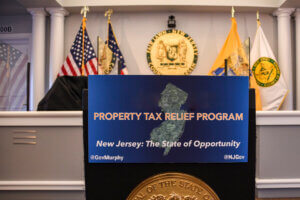In its regular tracking of New Jerseyans’ satisfaction with life in their state, the Monmouth University Poll found that the current Garden State Quality of Life Index has ticked up another notch to +25. This marks the third consecutive increase in the index.
“We have seen some upward movement in the Garden State Quality of Life Index over the past few months, led by increasingly positive views of towns and schools,” said Patrick Murray, director of the Monmouth University Polling Institute.
Currently, 2-in-3 residents rate the state of New Jersey as either an excellent (15%) or good (47%) place to live. This 62% positive rating is down slightly from October. However, ratings of residents’ own towns stand at 33% excellent and 41% good. The 33% excellent number matches the prior three-decade high for this measure.
Ratings of local schools have ticked up as well, to 26% excellent and 42% good. This 68% positive rating marks an all-time high on this question in polls going back to 1978.
Positive views of other local concerns stayed stable, including ratings of the local environment (77%) and crime (62%).
Examining the Garden State Quality of Life Index across various demographic groups, we currently find women (+30) much more positive than men (+20). There has also been an increase in the state’s urban communities, where the index now stands at +11, up from -1 in October. On the other hand, there has been a notable drop in the generally positive Central Hills area of New Jersey (Hunterdon, Somerset and Morris counties), with the score being +35, down from +45.
The Garden State Quality of Life Index was created by the Monmouth University Polling Institute to serve as a resident-based indicator of the quality of life offered by the state of New Jersey. The index is based on five separate poll questions: overall opinion of the state as a place to live – which contributes half the index score – and ratings of one’s hometown, the performance of local schools, the quality of the local environment, and feelings of safety in one’s own neighborhood. The index can potentially range from -100 to +100.
| GARDEN STATE QUALITY OF LIFE INDEX | |||||||||||
| NJ TOTAL | GENDER | AGE | RACE | INCOME | |||||||
| Male | Female | 18-34 | 35-54 | 55+ | White | Black/ Hispanic | <$50K | $50-100K | >$100K | ||
| February 2012 | +25 | +20 | +30 | +25 | +24 | +26 | +29 | +13 | +17 | +23 | +38 |
| October 2011 | +24 | +24 | +24 | +23 | +21 | +29 | +31 | +7 | +15 | +25 | +31 |
| August 2011 | +22 | +25 | +19 | +27 | +19 | +21 | +26 | +9 | +9 | +22 | +32 |
| May 2011 | +23 | +24 | +22 | +23 | +22 | +23 | +26 | +14 | +15 | +22 | +32 |
| December 2010 | +21 | +20 | +23 | +23 | +20 | +23 | +26 | +13 | +15 | +21 | +31 |
| GARDEN STATE QUALITY OF LIFE INDEX | ||||||||||
| REGION | COMMUNITY TYPE | |||||||||
| North east | Urban Core | Route 1 Corridor | Central Hills | Northern Shore | Delaware Valley | Garden Core | Urban | Stable Town | Growing Suburb | |
| February 2012 | +33 | +17 | +27 | +35 | +29 | +19 | +22 | +11 | +31 | +29 |
| October 2011 | +31 | +6 | +22 | +45 | +35 | +18 | +23 | -1 | +31 | +34 |
| August 2011 | +24 | +16 | +21 | +38 | +27 | +26 | +6 | +4 | +29 | +25 |
| May 2011 | +28 | +17 | +16 | +41 | +29 | +22 | +20 | +6 | +29 | +28 |
| December 2010 | +26 | +15 | +22 | +38 | +23 | +14 | +17 | +12 | +23 | +27 |
The latest Monmouth University Poll was conducted by telephone with 803 New Jersey adults from January 31 to February 4, 2012. This sample has a margin of error of ± 3.5 percent. The poll was conducted by the Monmouth University Polling Institute in West Long Branch, New Jersey.
DATA TABLES
The questions referred to in this release are as follows:
(* Some rows may not add to 100% due to rounding.)
1. Overall, how would you rate New Jersey as a place to live – excellent, good, only fair, or poor?
| TREND: |
Excellent | Good | Only Fair | Poor | (VOL) Don’t know |
(n) |
| February 2012 | 15% | 47% | 26% | 11% | 1% | (803) |
| October 2011 | 15% | 52% | 24% | 8% | 0% | (817) |
| August 2011 | 14% | 43% | 31% | 11% | 1% | (802) |
| May 2011 | 14% | 45% | 29% | 11% | 0% | (807) |
| December 2010 | 17% | 46% | 26% | 10% | 1% | (2864) |
| October 2007 | 17% | 46% | 25% | 12% | 1% | (1001) |
| August 2004 | 22% | 46% | 21% | 10% | 1% | (800) |
| May 2003 | 20% | 52% | 23% | 5% | 0% | (1002) |
| April 2001 | 23% | 53% | 19% | 4% | 1% | (802) |
| March 2000 | 25% | 51% | 17% | 6% | 0% | (800) |
| May 1999 | 22% | 54% | 19% | 5% | 0% | (800) |
| February 1994 | 18% | 53% | 22% | 7% | 0% | (801) |
| March 1990 | 21% | 47% | 25% | 6% | 1% | (800) |
| February 1988 | 27% | 51% | 17% | 4% | 1% | (800) |
| February 1987 | 31% | 53% | 11% | 4% | 0% | (800) |
| May 1985 | 29% | 52% | 14% | 3% | 1% | (500) |
| October 1984 | 29% | 51% | 15% | 4% | 1% | (1000) |
| January 1981 | 16% | 50% | 26% | 7% | 1% | (1003) |
| July 1980 | 18% | 50% | 23% | 7% | 2% | (1005) |
2. How would you rate your town or city as a place to live – excellent, good, only fair, or poor?
| TREND: |
Excellent | Good | Only Fair | Poor | (VOL) Don’t know |
(n) |
| February 2012 | 33% | 41% | 21% | 5% | 0% | (803) |
| October 2011 | 26% | 47% | 20% | 8% | 0% | (817) |
| August 2011 | 28% | 48% | 18% | 6% | 0% | (802) |
| May 2011 | 33% | 40% | 20% | 7% | 0% | (807) |
| December 2010 | 27% | 46% | 20% | 8% | 0% | (2864) |
| May 2003 | 29% | 45% | 19% | 7% | 0% | (1002) |
| April 2001 | 28% | 45% | 21% | 6% | 0% | (802) |
| May 1995 | 30% | 40% | 21% | 8% | 0% | (802) |
| June 1994 | 31% | 41% | 19% | 9% | 0% | (801) |
| September 1988 | 26% | 46% | 18% | 9% | 1% | (500) |
| October 1984 | 30% | 41% | 21% | 7% | 1% | (999) |
| June 1980 | 23% | 44% | 24% | 9% | 0% | (1005) |
| May 1977 | 25% | 41% | 24% | 10% | 0% | (1005) |
[QUESTIONS 3, 4 AND 5 WERE ROTATED]
3. How would you rate the quality of the environment in the area where you live – excellent, good, only fair, or poor?
| TREND: |
Excellent | Good | Only Fair | Poor | (VOL) Don’t know |
(n) |
| February 2012 | 29% | 48% | 17% | 5% | 0% | (803) |
| October 2011 | 25% | 47% | 19% | 9% | 0% | (817) |
| August 2011 | 31% | 48% | 16% | 5% | 0% | (802) |
| May 2011 | 33% | 46% | 15% | 6% | 0% | (807) |
| December 2010 | 14% | 52% | 25% | 9% | 0% | (2864) |
| April 2001 | 27% | 43% | 22% | 7% | 1% | (402) |
| September 1988 | 10% | 43% | 31% | 15% | 1% | (500) |
4. How would you rate the job your local schools are doing – excellent, good, only fair, or poor?
| TREND: |
Excellent | Good | Only Fair | Poor | (VOL) Don’t know |
(n) |
| February 2012 | 26% | 42% | 16% | 8% | 8% | (803) |
| October 2011 | 21% | 39% | 20% | 13% | 7% | (817) |
| August 2011 | 19% | 44% | 26% | 6% | 5% | (802) |
| May 2011 | 24% | 39% | 22% | 10% | 6% | (807) |
| December 2010 | 24% | 40% | 23% | 8% | 5% | (2864) |
| August 2004 | 24% | 37% | 17% | 12% | 9% | (800) |
| April 2001 | 21% | 43% | 21% | 6% | 9% | (802) |
| September 1999 | 18% | 44% | 21% | 9% | 8% | (802) |
| September 1998 | 20% | 42% | 23% | 9% | 7% | (804) |
| February 1996 | 20% | 40% | 20% | 11% | 9% | (804) |
| September 1993 | 16% | 36% | 29% | 14% | 5% | (801) |
| January 1992 | 15% | 38% | 26% | 15% | 5% | (800) |
| October 1987 | 14% | 46% | 23% | 6% | 11% | (500) |
| October 1986 | 15% | 40% | 26% | 10% | 9% | (800) |
| October 1983 | 16% | 43% | 23% | 10% | 8% | (802) |
| May 1978 | 12% | 40% | 25% | 12% | 11% | (1003) |
5. How safe do you feel in your neighborhood at night – very safe, somewhat safe, or not at all safe?
| TREND: |
Very safe | Somewhat safe | Not at all safe | (VOL) Don’t know |
(n) |
| February 2012 | 62% | 32% | 5% | 0% | (803) |
| October 2011 | 62% | 31% | 7% | 0% | (817) |
| August 2011 | 63% | 31% | 6% | 0% | (802) |
| May 2011 | 68% | 27% | 5% | 0% | (807) |
| December 2010 | 59% | 35% | 6% | 0% | (2864) |
| February 1993 | 42% | 44% | 13% | 0% | (801) |
| October 1987 | 51% | 36% | 11% | 2% | (499) |
| October 1984 | 53% | 36% | 9% | 2% | (500) |
| May 1981 | 43% | 43% | 13% | 1% | (497) |
[Note: All trend results prior to 2005 come from Rutgers University’s Eagleton Poll.]
The Monmouth University Poll was conducted by the Monmouth University Polling Institute on January 31 to February 4, 2012 with a statewide random sample of 803 adult residents, including 641 contacted on a landline telephone and 162 on a cell phone. Live interviewing services were provided by Braun Research, Inc. and the telephone sample was obtained from Survey Sampling International. Monmouth is responsible for all aspects of the survey questionnaire design, data weighting and analysis. For results based on the total sample, one can say with 95% confidence that the error attributable to sampling has a maximum margin of plus or minus 3.5 percentage points. Sampling error increases as the sample size decreases, so statements based on various population subgroups, such as separate figures reported by gender or party identification, are subject to more error than are statements based on the total sample. In addition to sampling error, one should bear in mind that question wording and practical difficulties in conducting surveys can introduce error or bias into the findings of opinion polls.
|
POLL DEMOGRAPHICS (weighted) | |||
| 36% Dem | 49% Male | 29% 18-34 |
63% White |
| 22% Rep | 51% Female | 39% 35-54 |
12% Black |
| 42% Ind | 32% 55+ |
15% Hispanic | |
|
9% Asian/Other | |||
Region is defined by county boundaries: Northeast (Bergen, Passaic), Urban Core (Essex, Hudson), Route 1 Corridor (Mercer, Middlesex, Union), Central Hills (Hunterdon, Morris, Somerset), Northern Shore (Monmouth, Ocean), Delaware Valley (Burlington, Camden, Gloucester), and Garden Core (Atlantic, Cape May, Cumberland, Salem, Sussex, Warren).
It is the Monmouth University Polling Institute’s policy to conduct surveys of all adult New Jersey residents, including voters and non-voters, on issues that affect the state. Specific voter surveys are conducted when appropriate during election cycles.
Click on pdf file link below for full methodology and results by key demographic groups.




